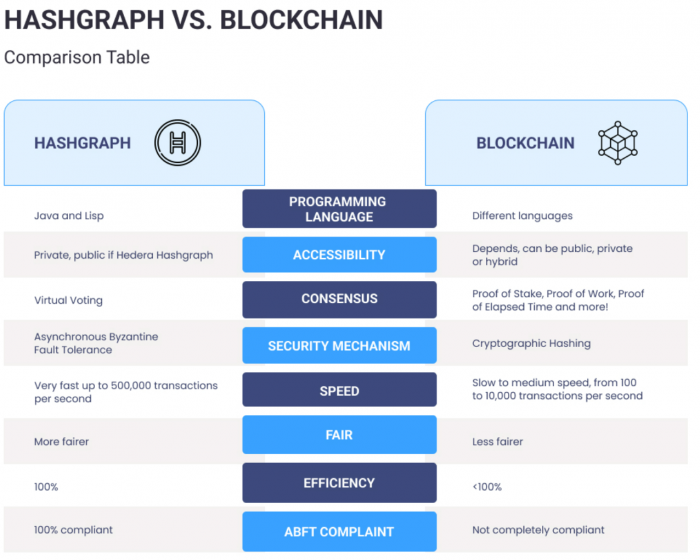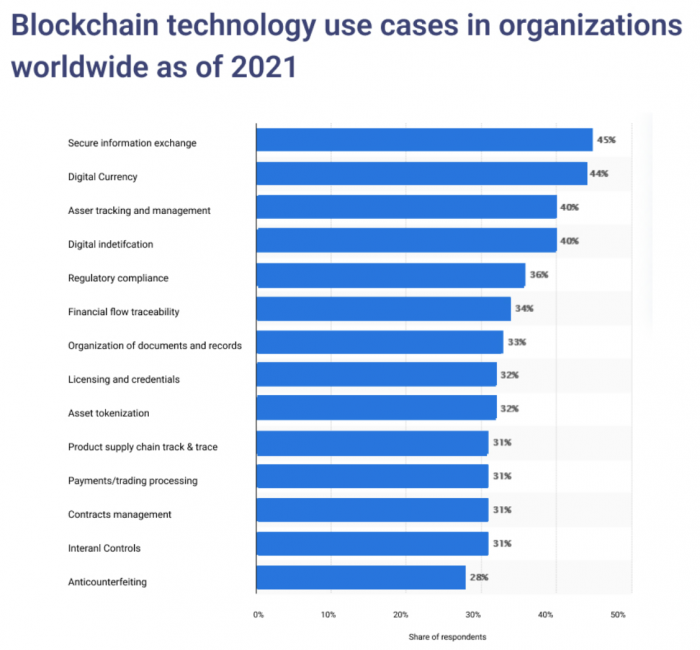Blockchain has been called the most disruptive innovation, and its potential applications are seemingly endless. While Blockchain remains widely used, there’s another type of distributed ledger on the horizon with the potential to change the way people make transactions online: Hashgraph.
So, which blockchain solution will eventually dominate the market? Let’s take a closer view at two prominent contenders, Hashgraph vs. Blockchain, their main differences, and a look in detail.
Comparison Table: Hashgraph vs. Blockchain

Source: codersdaddy
What is Blockchain?
A blockchain is a ledger of records that are distributed across many computers. It’s a distributed ledger because it doesn’t rely on one central database or server. Instead, information is shared and replicated across an entire network.
An excellent way to think about it is like Google Docs, but for money (or anything else of value). When someone wants to make a change, that change is sent to everyone in the network. It must get approved by consensus before being added.
So, tampering is nearly impossible because there would need to be a collaboration between all computers for fraud, mistakes, or information manipulation. It also protects against hacking attacks or theft because someone trying to make these changes would need access and permissions from multiple servers.
Which Consensus Mechanism Blockchain Relies Upon?
Blockchain technology relies on Proof of Work (PoW) as its consensus mechanism. Theoretically, this is the most secure way for a decentralized network to reach consensus and confirm transactions.
PoW miners are paid in bitcoin or another cryptocurrency for running the mining software on their computer. Bitcoin, Ethereum, and Litecoin are examples of cryptocurrencies that use PoW as their consensus mechanism.
It also relies upon the following:
Proof of Stake: It is another type of consensus mechanism used by coins like Peercoin, BlackCoin, ShadowCash, NuShares, Nxt, and others. With proof-of-stake coins, people can generate new blocks by having some of the currency they own put up as a stake. If you want to participate in block generation but don’t have any coins at stake, you can buy some from someone who does and trade them back when you’re done.
Proof of Elapsed Time: While not widely used today, this is a relatively new consensus mechanism created to solve many of the issues found in both Proof of Work and Proof of Stake. In it, miners will calculate how much time has elapsed since previous blocks using an agreed-upon algorithm.
Leader-Based Consensus: There are two types of leader-based consensus mechanisms that blockchain technology uses – one-leader and multi-leader. One leader means only one person or group determines what goes into the Blockchain. Multi-leader means multiple individuals or groups are deciding what goes into the Blockchain.
Economy-Based Consensus: Economy-based consensus works very differently than the three described above. Rather than having miners solve math problems to create new blocks, economy-based consensus relies on economic incentives provided by proofs of work. They did this through two different models: proof of stake and delegated proof of stake.
Voting Based Consensus: This works on voting rather than computation. Each participant will be given a voting weight proportional to the number of tokens they hold.
For businesses trying to decide whether or not it’s a good idea to invest in Blockchain, there are some essential things they should keep in mind. The first is Blockchain’s decentralized nature, which requires an entirely new way of thinking about information sharing. There is no central authority; information is shared across a vast network.
So using Blockchain allows you to remove the need for trust and instead use consensus. While that may sound like a difficult thing to achieve, you can hire blockchain developers in India who can customize it as per your need. Moreover, blockchain also offers more security and transparency compared with other options on the market today.
All parties involved can see what data has been changed when changes were made and by whom. In short, this helps facilitate reliable agreements between parties without third-party interference.
Projects Suitable for Blockchain Development

Source: Statista
Since blockchains are decentralized networks without a central point of failure, they provide excellent protection against data tampering than any system that exists today. Immutability is what makes them so appealing—and why they could become such an essential part of our economy in decades to come.
Overall, it is best suited for projects that require immutability (such as finance) or transparency (such as democratic voting). Blockchain can also be used in conjunction with other data security measures.
When you want to build a blockchain app today, it must be highly technical and developed by experts with knowledge of cryptocurrency protocols. Hire Ethereum Developers in India to ensure your project is completed successfully and on time.
What is Hashgraph?
Hashgraph is a DAG structure with a different consensus algorithm, similar to Blockchain. Due to their differences in architecture and consensus algorithms (DSA versus PoW/PoS), it is incorrect to say that these are competitors. The only thing they have in common is that they are both distributed ledgers, with Blockchain being more like DLT 1.0 and Hashgraph being like DLT 2.0.
Hashgraph is private and uses Gossip about Gossip protocol to reach consensus. In this protocol, each node shares the gossip information with other nodes it has contact with. For example, if node A shares gossip B to node C, node C will share gossip B again among all nodes it has contact with.
When every node has heard from at least one other node, which means they can create a unique chain of messages within the whole network based on a set of rules, new transactions can be confirmed as valid by consensus on the chain.
Which Consensus Mechanism Hashgraph Relies Upon?
It works on a graph-like structure, and the consensus is achieved by nodes reaching out to each other. For any changes to be made, they need at least two-thirds of the members in agreement.
If a change needs to be made and one node disagrees, the algorithm will automatically update around that node until it joins in agreement with the others. Thus, It can reach consensus faster and more efficiently than other blockchain technologies.
Overall public Hashgraph network works upon the following:
Gossip about Gossip: This involves spreading gossip from node to node across the entire network, which provides a decentralized way of propagating messages. However, this process does not have an inherent proof-of-work component, so nodes do not compete against each other as they would on Bitcoin or Ethereum’s networks.
Virtual Voting: Hashgraph uses something called virtual voting. Here every participating node votes for its closest neighbor based on closeness defined by proximity in terms of timing among all participants relative to when events occur across the network.
Unlike Blockchain, it promises no mining competition, which can lead to slower speeds and higher transaction fees. It also claims faster transaction times—from 2 seconds on average (including verification) down to just three milliseconds—and more secure transactions thanks to a fair-play system of fairness for all players.
And if that wasn’t enough, Hashgraph is also said to be more private than a typical blockchain network by ensuring data security and maintaining control over your personal information.
So, what kind of projects are compatible with Hashgraph?
Hashgraph is suitable for any project requiring trust between multiple parties, such as enterprise supply chain networks, financial markets, and government institutions, down to digital asset exchanges.
Every party involved in a given network must be able to rely on each other’s information, so a situation where their interests aren’t aligned will break everything.
So, it is a perfect fit for trading platforms, as it allows all users. It ensures that even those who aren’t directly connected enjoy equal access while mitigating the risk of theft or fraud.
Over to You
I hope you now have a distinct idea on Hashgraph vs. Blockchain by now. Blockchains and Hashgraph are two key players in the DTL space. The choice depends on what your business needs from a DLT system.
So, analyze your requirements and then decide which is best for you! Leverage case studies and live projects with blockchain and Hashgraph technologies to decide which one suits your use case best.



